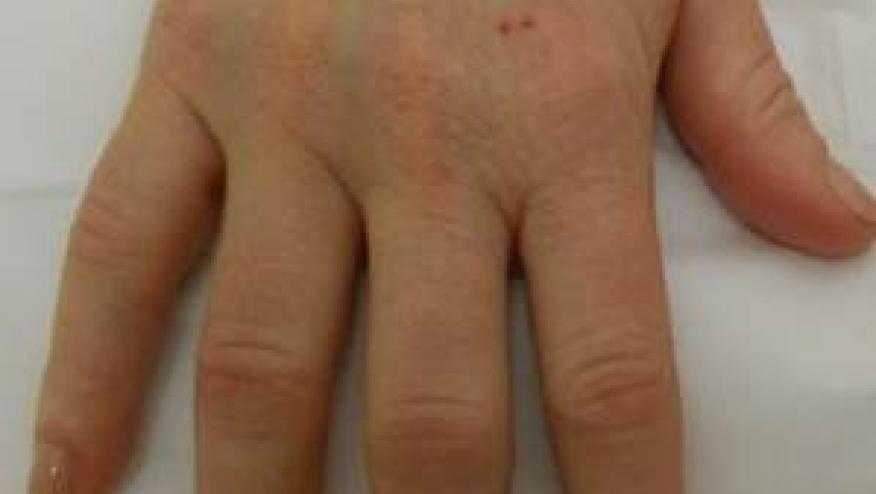Biologics Keep Early RA in Check for at Least One Year Save

Treatment with at least some biologic drugs significantly reduced 1-year progression of early rheumatoid arthritis (RA) relative to classical small-molecule agents, researchers reported.
Patients assigned to certolizumab pegol (Cimzia) or abatacept (Orencia) in the approximately 800-participant NORD-STAR trial were in remission after 48 weeks at rates of 52.3% and 59.3%, respectively, compared with 39.2% randomized to conventional disease-modifying anti-rheumatic drug (DMARD) therapy (P<0.05 for both), according to Mikkel Østergaard, MD, PhD, of Rigshospitalet in Copenhagen, Denmark, and colleagues.
A fourth arm assigned to tocilizumab (Actemra) achieved 48-week remission at a rate of 51.9%, but this just missed the threshold for statistical significance, the group reported in Annals of the Rheumatic Diseasesopens in a new tab or window. As well, the biologic groups did not develop significantly less radiographic progression versus the conventional treatment, although rates were all very low.
The researchers conceived NORD-STAR in 2011 to examine whether starting biologic drugs right away when RA is first diagnosed would improve outcomes over "conventional" therapy (i.e., methotrexate and/or other standard small-molecule agents). Interim results, reported at a conference in 2020opens in a new tab or window based on 24-week data, were generally in the same direction as the new analysis.
The idea, of course, was to see whether the RA disease trajectory can be flattened if aggressive (that is, targeted biologic therapy on top of methotrexate) treatment is started early, whether or not patients have responded to methotrexate or similar agents by themselves. Despite some trials involving individual biologics that found them superior to conventional DMARDs in early RA, the newer drugs "are perceived as having overall similar efficacy," Østergaard and colleagues explained, with current guidelines still recommending conventional treatment as the starting point.
The three biologics chosen for NORD-STAR have different mechanisms of action. Certolizumab pegol inhibits tumor necrosis factor (TNF), tocilizumab targets interleukin-6, and abatacept binds certain proteins on T cells to block their activation. Each of these was accompanied by methotrexate, and patients could receive intra-articular steroid injections if warranted. The control therapy consisted of oral prednisolone (discontinued after month 9) or a combination of sulfasalazine, hydroxychloroquine, and intra-articular steroid injections; the choice depended on what was considered standard in the individual countries. These injections were prohibited in all groups during the 4 weeks prior to the interim and final evaluations so as not to bias the results.
Endpoints were led by the Clinical Disease Activity Index (CDAI), with a score ≤2.8 defined as remission. Baseline CDAI scores averaged 27-29 in the four groups. The researchers also tracked the 28-joint Disease Activity Score as modified by C-reactive protein level (DAS-28), tender and swollen joint counts, and other common measures including the van der Heijde-Sharp systemopens in a new tab or window for scoring radiographic progression. Adverse events were tallied, too.
Baseline characteristics included a mean age of about 55, 70% were women, and mean symptom duration was about 7-8 months. The lapse between diagnosis and enrollment averaged only about 2 weeks. About 200 patients were assigned to each treatment arm and, importantly, assignments were not blinded.
Secondary efficacy outcomes mostly tracked those for CDAI remission. Remission rates under DAS-28, for example, were in the range of 67%-71% for the three biologics versus 54% in the control arm (differences all highly significant); the same was true for the Simplified Disease Activity Index. Patients receiving biologics reported significantly less pain at week 48 than did controls, by about 5 points on a 100-point scale. This was matched by physician's global assessments.
Adverse event rates were generally similar among the four study arms, although infections appeared more numerically common with tocilizumab than the other agents (58% vs 47%-49%). Also, while event rates otherwise did not vary much, events may have been more severe for the biologics groups: from 2% to 11% discontinued because of adverse effects, compared with 1% of controls.
On the other hand, more patients assigned to the conventional treatment quit because of inadequate response (11% vs 1%-4%).
Limitations to the study included the selection of agents to test; although the pharmacological toolbox for RA has expanded markedly since the trial began, there were still others, notably the market leader adalimumab (Humira), that could have been chosen. The trial necessarily did not include any Janus-activated kinase inhibitors as these were not yet available. The study also was not powered to examine patient subgroups, such as those with lower versus higher disease activity at baseline. Østergaard and colleagues additionally cited the open-label design as a limitation.









If you are a health practitioner, you may Login/Register to comment.
Due to the nature of these comment forums, only health practitioners are allowed to comment at this time.